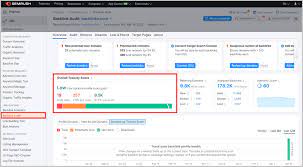Semrush Subdomain Backlinks: Boosting Your Website’s Authority
When it comes to search engine optimization (SEO), backlinks play a crucial role in determining the authority and visibility of your website. They are like votes of confidence from other websites, indicating that your content is valuable and trustworthy. In the realm of SEO, subdomain backlinks have emerged as a powerful strategy to enhance your website’s online presence.
Understanding Subdomain Backlinks
A subdomain is a part of your main domain that can be used to organize and categorize different sections or types of content on your website. For example, if your main domain is “example.com,” a subdomain could be “blog.example.com” or “shop.example.com.”
Subdomain backlinks, as the name suggests, are backlinks pointing specifically to the subdomains of your website. These links can come from external websites or internal pages within your own domain.
The Benefits of Subdomain Backlinks
Enhanced Domain Authority: By building quality backlinks to specific subdomains, you can boost the overall authority and credibility of your entire website. Search engines consider the authority of individual subdomains when determining the ranking potential of your main domain.
Targeted Traffic: Subdomains can cater to specific topics or niches within your industry. By acquiring relevant backlinks to these subdomains, you can attract targeted traffic that is more likely to convert into customers or engaged users.
Improved Indexing: Search engines treat subdomains as separate entities from the main domain. This means that by acquiring backlinks specifically for subdomains, you increase their chances of being indexed and ranked independently in search engine results pages (SERPs).
Tips for Building Subdomain Backlinks
Content Relevance: Ensure that the content on your subdomains is highly relevant to the backlinks you aim to acquire. This will increase the chances of other websites linking to your subdomains naturally.
Outreach and Guest Posting: Reach out to relevant websites or bloggers in your industry and offer to contribute high-quality guest posts that link back to your subdomains. This can help you establish connections, gain exposure, and acquire valuable backlinks.
Internal Linking: Utilize internal linking within your own domain to direct traffic and distribute link equity to your subdomains. This can help search engines understand the structure of your website better and improve the visibility of your subdomain pages.
Monitoring Subdomain Backlinks with Semrush
Semrush, a leading SEO tool, offers comprehensive features to monitor and analyze backlinks for both main domains and subdomains. With Semrush’s Backlink Analytics tool, you can track the quantity and quality of backlinks pointing specifically to your subdomains.
The tool provides detailed insights into referring domains, anchor texts, follow vs. nofollow links, and more. By monitoring these metrics regularly, you can identify opportunities for improvement, track the success of your link-building campaigns, and make data-driven decisions to enhance your website’s SEO performance.
Conclusion
Incorporating a strategic approach towards building subdomain backlinks can significantly impact your website’s authority, visibility, and organic rankings. By leveraging the power of Semrush’s tools alongside effective link-building strategies, you can strengthen your online presence, attract targeted traffic, and stay ahead in the competitive world of SEO.
Understanding Subdomain Backlinks: SEO Implications and Google’s Treatment of Subdomains
- Can we do SEO for subdomain?
- Does Google treat subdomains as separate sites?
- What are subdomain backlinks?
- Why subdomains are bad for SEO?
Can we do SEO for subdomain?
Yes, SEO can be done for subdomains. Subdomains are treated as separate entities by search engines, which means they can be optimized individually to improve their visibility and rankings in search engine results pages (SERPs). By implementing SEO techniques such as keyword research, on-page optimization, quality content creation, and link building specifically for subdomains, you can enhance their authority and attract targeted traffic. It is important to ensure that the content on your subdomain is relevant and valuable to your target audience. By utilizing SEO strategies for subdomains, you can effectively boost your overall website’s online presence and increase its chances of ranking higher in search engine results.
Does Google treat subdomains as separate sites?
Yes, Google treats subdomains as separate entities from the main domain. Each subdomain is considered a distinct website by search engines. This means that the authority, rankings, and indexing of subdomains can be evaluated independently. By building backlinks specifically to subdomains, you can enhance their visibility and potentially improve their rankings in search engine results pages (SERPs). It’s important to note that while subdomains are treated separately, they can still contribute to the overall authority and credibility of the main domain.
What are subdomain backlinks?
Subdomain backlinks refer to the backlinks that specifically point to the subdomains of a website. A subdomain is a part of the main domain that can be used to categorize and organize different sections or types of content. These backlinks can come from external websites or internal pages within the same domain. Subdomain backlinks are valuable because they not only enhance the authority and credibility of the entire website but also attract targeted traffic to specific sections or niches within the site. By acquiring relevant and high-quality backlinks for subdomains, website owners can boost their overall SEO performance and improve their chances of ranking higher in search engine results pages.
Why subdomains are bad for SEO?
The belief that subdomains are bad for SEO is a common misconception. While it is true that subdomains can present certain challenges, they are not inherently detrimental to your website’s search engine optimization efforts. Subdomains can actually be beneficial in organizing and categorizing different sections of your website, allowing for targeted optimization and improved user experience. However, it is important to ensure that each subdomain has unique, high-quality content and relevant backlinks to maximize their SEO potential. With proper planning and strategic implementation, subdomains can be effectively utilized to enhance your website’s overall visibility and authority in search engine rankings.

